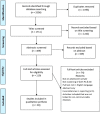Activity-related behavior typologies in youth: a systematic review
- PMID: 31097036
- PMCID: PMC6524235
- DOI: 10.1186/s12966-019-0804-7
Activity-related behavior typologies in youth: a systematic review
Abstract
Background: Clusters of adolescents differentiated by patterns of physical activity and sedentary behavior (activity-related typologies) are common. Understanding both the characteristics of adolescents and modifiable correlates of these typologies, can help to develop interventions for those most at risk. This systematic review aimed to synthesize the socio-demographic characteristics and modifiable correlates of activity-related behavioral typologies among adolescents.
Methods: A systematic search of seven electronic databases was conducted to identify quantitative studies using person-oriented statistical approaches to identify activity-related behavioral typologies among 12-18 year-olds. This systematic review was registered in Prospero (registration number: CRD42016046879).
Results: Thirty-six studies met the inclusion criteria and were classified according to three sub-themes based on behaviors included in the typologies (1. physical activity and sedentary behavior only; 2. physical activity, sedentary behavior and risk-related behaviors; 3. physical activity, sedentary behavior and diet). Studies were mostly cross-sectional and relied on self-report measures. Methods were considerably heterogeneous, however results revealed some consistency in typologies within specific groups. For example, typologies characterized by unhealthy behavior patterns (e.g., characterized by physical inactivity, high sedentary behavior and poor diet or high risk-related behaviors) comprised more older adolescents. With the exception of socio-demographics (age, sex, body mass index and socio-economic status), very few correlates have been studied to date (mostly school-related behavioral factors and intrapersonal influences), with evidence largely from typologies comprised of physical activity, sedentary behavior and diet.
Conclusions: More research is needed to assess a range of modifiable correlates associated with activity-related behavior typologies among adolescents. This will allow for more targeted interventions, to achieve long-lasting, positive behavior change in adolescent populations.
Keywords: Adolescents; Correlates; Physical activity; Sedentary behavior; Typologies.
Conflict of interest statement
The authors declare that they have no competing interests.
Figures
References
Publication types
MeSH terms
LinkOut - more resources
Full Text Sources
Medical
Miscellaneous


